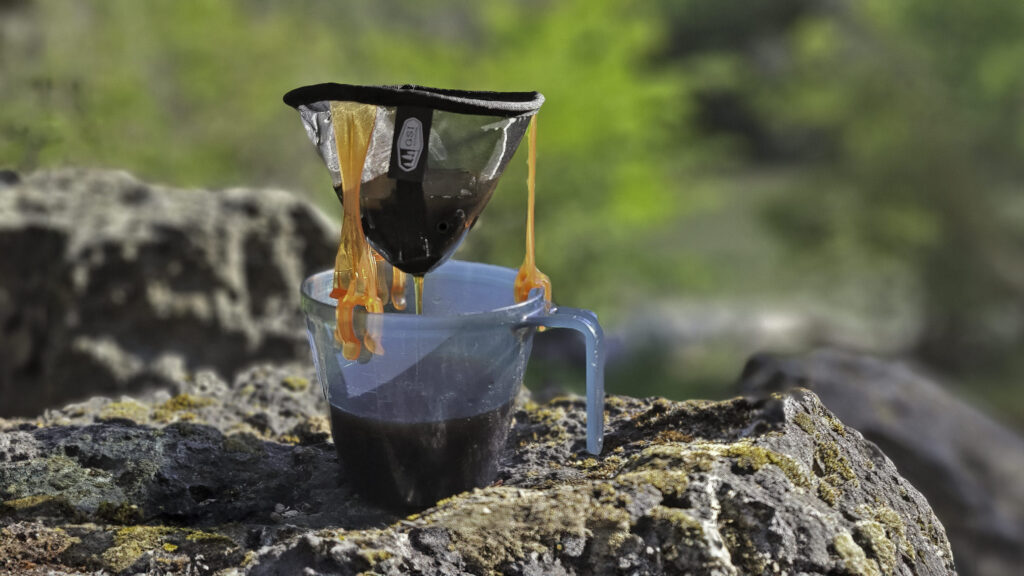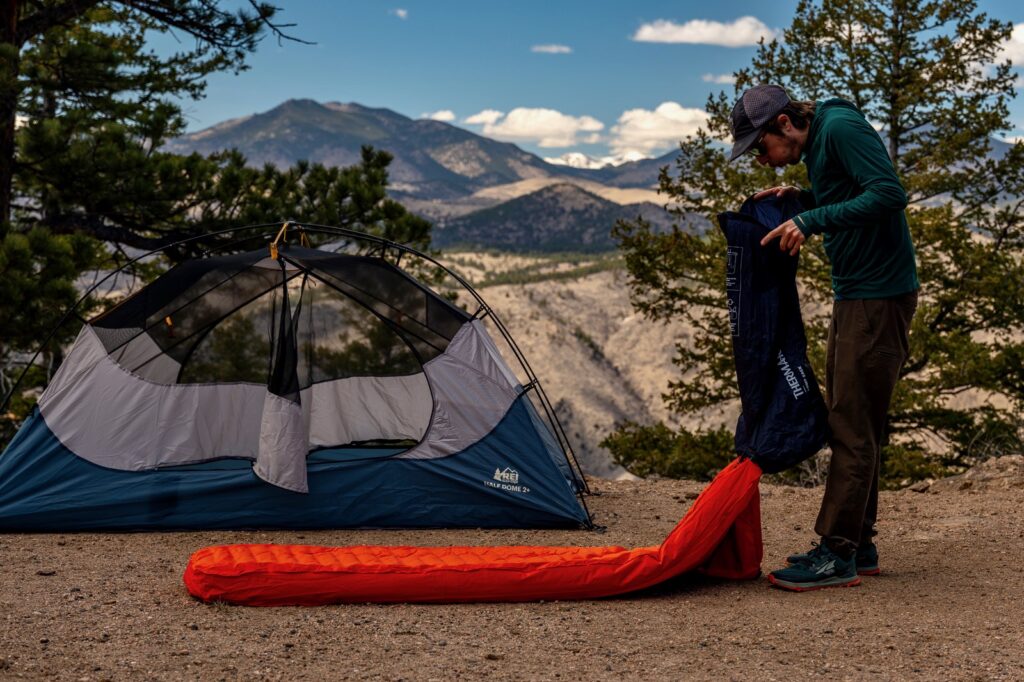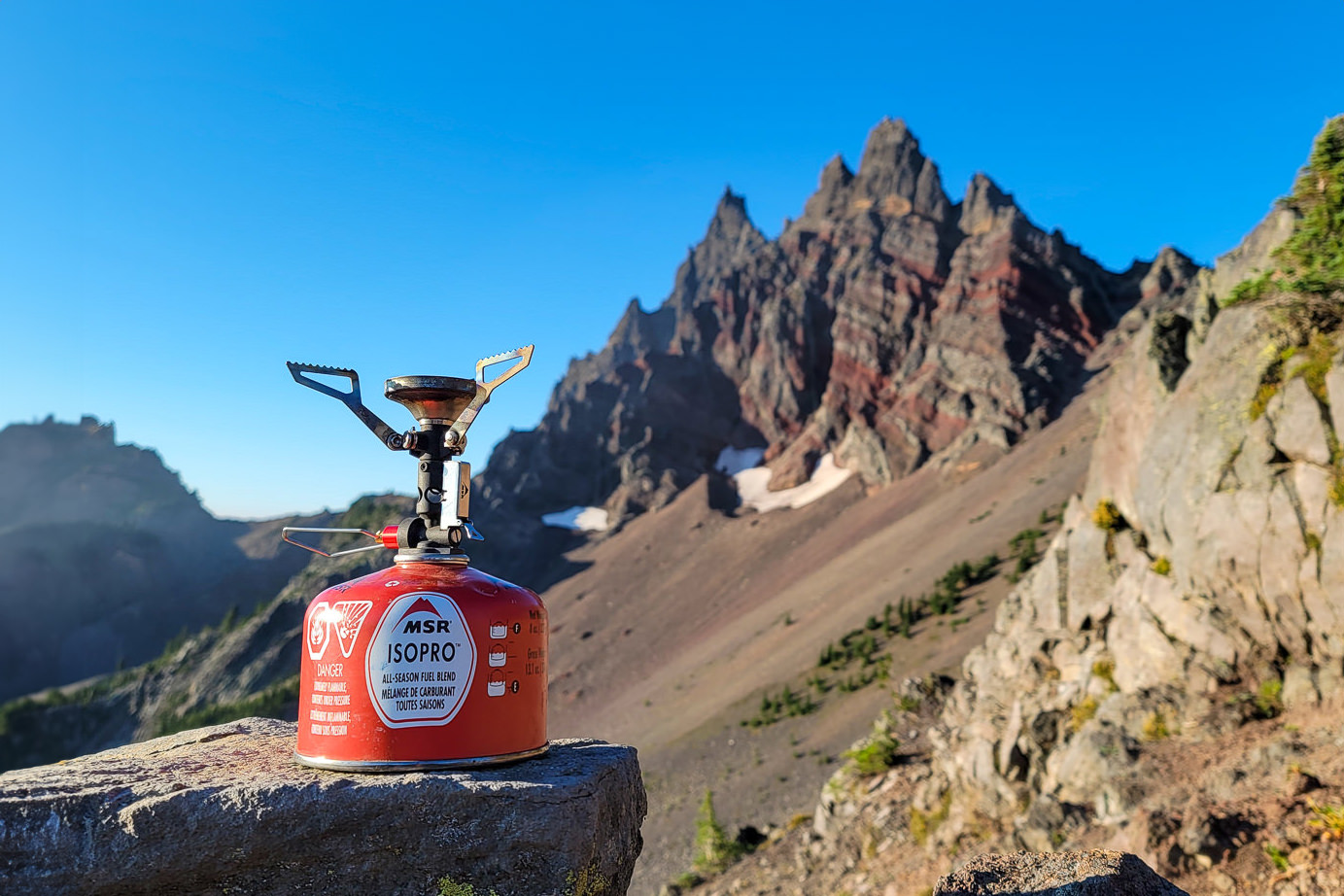
A backpacking stove can enhance your wilderness adventures in a way that few other tools can, whether you’re a boil-water-and-let-it-sit kind of hiker or more of a backcountry gourmet. Key features like convenience, weight, packability, power, efficiency, and precision can determine which stove is right for you.
We’ve researched and tested over 40 of the best backpacking stoves available across the sky-high mountains of Nepal, the freezing ridges of Mt. Hood, and just about everywhere in between. We used our experience and expertise to narrow down this list of our absolute favorites.
And for more info, check out some of our other popular gear guides:
Quick Picks for Backpacking Stoves
Check out this quick list of the best backpacking stoves if you’re in a hurry, or continue scrolling to see our full list of favorites with in-depth reviews.
Best Backpacking Stove Overall: MSR PocketRocket 2 ($50)
Efficient Stove with Excellent Wind Performance: SOTO WindMaster ($70)
Highly Wind-Resistant Integrated Stove System: MSR WindBurner ($200)
Best Value Integrated Stove System: Jetboil Flash ($130)
Best Budget Stove & Cookset Bundle: SOTO Amicus Cookset Combo ($50)
Integrated Stove System with Wide Cookpot & Simmer Control: Jetboil MiniMo ($170)
Affordable Stove with a Wide Burner: Primus Essential Trail Stove ($30)
Ultralight Canister Stove with a Tiny Packed Size: Snow Peak LiteMax ($60)
High-Efficiency Wood Burning Stove: Solo Stove Lite ($70)
Best Liquid Fuel Stove for Winter Treks: MSR WhisperLite ($140)
Best Budget Ultralight Stove: BRS 3000T ($20)
Durable Canister Stove with Convenient Features: Snow Peak GigaPower 2.0 ($50)
What’s new
We’ve put a batch of updated stoves and tried and true favorites through another round of testing over the course of dozens of nights and hundreds of meals on trail.
- The MSR PocketRocket 2 held up along the length of the Colorado Trail and did not disappoint, keeping its spot as best overall backpacking stove.
- The new version of the JetBoil Flash has been updated with a more streamlined design, new igniter switch and fuel valve, and a handy rubber grip.
- We put the BRS 3000T to the test through thousands of miles on trail.
Backpacking Stoves OVerall Testing Scores

MSR PocketRocket 2
Best Backpacking Stove Overall
CleverHiker Rating: 4.8/5.0
Price: $50
Weight: 2.6 oz.
Fuel Type: Isobutane/propane canister
Boil Time: 3m 30s
Burn Time (8 oz. fuel): 60m
Pros
- Ultralight
- Compact
- Durable
- Simmer control
- Efficient
Cons
- Somewhat bulky carrying case
- Not as good in wind as some
The MSR PocketRocket 2 is a lightweight, compact, and durable stove that won’t break your budget. During testing, the PocketRocket 2 consistently outperformed more expensive stoves with its great simmer control and fast boil times.
One unique feature is the hard plastic storage case that comes with the PocketRocket 2. This keeps the stove protected from debris and ensures it won’t get bent or damaged in your backpack. We sometimes opt to leave the case behind when we want to go as light as possible, but it only weighs 1.6 oz. – not a big penalty for the added peace of mind.
MSR also offers the PocketRocket 2 Kit, which comes with the stove, a pot, a bowl, a straining lid, and a pot grip. The kit is an awesome value if you’re looking for a complete cooking setup.
Another upgrade you can opt for is the MSR PocketRocket Deluxe (which is also available as a Stove Kit). The Deluxe comes with a push button igniter, a pressure regulator to help performance in cold temps and at high altitude, and a recessed burner head for improved wind performance.
The standard PocketRocket 2 is a great choice for seasoned thru-hikers and backpacking novices alike. Though the Deluxe has a more robust regulator for high altitude and cold weather, we’ve never had an issue with the PocketRocket 2.

SOTO WindMaster
Efficient Stove with Excellent Wind Performance
CleverHiker Rating: 4.7/5.0
Price: $70
Weight: 3.1 oz.
Fuel Type: Isobutane/propane canister
Boil Time: 3m 5s
Burn Time (8 oz. fuel): 70m
Pros
- Performs well in wind
- Lightweight
- Efficient
- Push-button igniter
- Stable pot support
- Simmer control
Cons
- Slightly bulkier than some
- Expensive
The SOTO WindMaster is a highly efficient stove that, as the name would imply, performs beautifully in windy conditions. This powerful little stove boils very quickly and is noticeably quieter than many other stoves we’ve used.
The WindMaster outperforms other stoves in windy conditions because the recessed burner has a lip around it, and there’s very little open space between the burner head and the pot. This means there’s not a lot of room for wind to interfere with your flame, and the result is a faster and more efficient boil in unideal conditions.
We also love that the WindMaster can be adapted to suit different pots. You have the option to attach the included 4-prong support for larger cooksets, or you can purchase an ultralight 3-prong attachment for small pots. While the WindMaster is slightly bulkier than some of our other favorite canister stoves, it’s still quite manageable and packs a lot of power for such a neat little package.

MSR WindBurner
Highly Wind-Resistant Integrated Stove System
CleverHiker Rating: 4.6/5.0
Price: $200
Weight: 15.3 oz.(Stove & Pot)
Fuel Type: Isobutane/propane canister
Boil Time: 2m 55s
Burn Time (8 oz. fuel): 95m
Pros
- Performs well in wind
- Convenient
- Fast boil time
- Pot included
Cons
- Expensive (but comes with pot)
- Simmer control isn’t great
- Heavy & bulky for backpacking
The MSR WindBurner is another extremely convenient integrated stove system. The main advantage it has over other integrated systems is its excellent wind resistance. Stiff winds can greatly reduce stove efficiency, but that’s not an issue with the WindBurner. The WindBurner also has excellent simmer control and some of the fastest boil times, making it a breeze to cook with.
Although it is one of the highest-performing and most efficient of the integrated stoves we tested, it is also the heaviest and has the highest price tag. If you’re after something slightly lighter, with more convenient features, and in a more budget-friendly package, we recommend checking out the JetBoil Flash or MiniMo.

Jetboil Flash
Best Value Integrated Stove System
CleverHiker Rating: 4.6/5.0
Price: $130
Weight: 13.1 oz.
Fuel Type: Isobutane/propane canister
Boil Time: 2m 40s
Burn Time (8 oz. fuel): 50m
Pros
- Convenient
- Fast boil time
- Pot included
- Push-button igniter
- Performs well in wind
Cons
- Expensive (but comes with pot)
- No simmer control
- Heavy & bulky for backpacking
The JetBoil Flash is a long-standing favorite amongst integrated stove users. With new features to enhance comfort and usability, the most recent version has only raised the bar.
With a lightning fast boil time of under three minutes per liter, the Flash won’t leave you waiting around for a hot meal. The excellent wind blocking and heat transfer also helps conserve fuel to ensure each canister will go the extra mile. Although it excels more at boiling water than simmering due to its lack of a fuel regulator (see the MiniMo for better simmer control), the new version of the Flash seems to have a touch more precision than the older version. This may simply be due to its upgraded turn-and-click fuel knob.
The new fuel knob feels significantly smoother and sturdier than the old wire knob that most other integrated systems are still using. The new turn-and-click igniter switch is also built into the top end of the knob – another upgrade over the push style igniter switch which was notably more fragile.
The Flash still has its preexisting features like the pour spout lid, heat-indicating neoprene cozy, and pot stabilizer, but it has also upgraded the stove housing. The stove now has a comfy, rubber handle and is more streamlined than previous versions. The new design hasn’t shed any weight, but it takes up less space when packed away.
The handy features and ease of use unfortunately come at the cost of weight savings when compared to more ultralight options. However, for beginner backpackers or extreme conditions, the fast boil time, wind resistance, and extra convenience are worth their weight in gold.

Soto Amicus Cookset Combo
Best Budget Stove & Cookset Bundle
CleverHiker Rating: 4.4/5.0
Price: $50
Weight: 11.2 oz. / 2.7 oz.(Stove & Pot/Stove Only)
Fuel Type: Isobutane/propane canister
Boil Time: 4m 20s
Burn Time (8 oz. fuel): 90m
Pros
- Ultralight
- Affordable
- Two pots included
- Simmer control
- Stable pot support
- Performs well in wind
Cons
- Pots don’t have measurement marks
The SOTO Amicus Stove Cookset Combo is a super affordable bundle that includes both an ultralight stove and a pot. The Amicus stove has good simmer control, four locking legs that provide solid pot support, a push-button igniter, and a recessed burner for increased performance in the wind.
The cookware that comes with this set is somewhat basic, but it’s lightweight and gets the job done efficiently. We like that the pot has a generous capacity so we can heat enough water for everything at once, and the deep lid can be used as a separate cup.
We recommend the Amicus Combo to anyone on a budget who needs a complete, lightweight cook system for backpacking.

Jetboil MiniMo
Integrated Stove System with Wide Cookpot & Simmer Control
CleverHiker Rating: 4.3/5.0
Price: $170
Weight: 14 oz.(Stove & Pot)
Fuel Type: Isobutane/propane canister
Boil Time: 3m 30s
Burn Time (8 oz. fuel): 30m
Pros
- Convenient
- Fast boil time
- Simmer control
- Pot included
- Push-button igniter
- Performs well in wind
Cons
- Expensive (but comes with pot)
- Heavy & bulky for backpacking
The Jetboil MiniMo is a complete cooking system that’s just about as convenient and efficient as backcountry stoves get. We especially love this particular model for a variety of cooking applications. The MiniMo is loaded with useful features including a sturdy handle, push-button igniter, excellent simmer control, and a stout shape that makes eating out of it easier. The MiniMo is slightly heavier and more expensive than some ultralight stove/pot combinations, but its speed, convenience, and stability make it exceptional for the backcountry. The Jetboil MicroMo is the same stove with a slimmer and slightly smaller pot to reduce weight. The Jetboil Flash is less expensive and also excellent, but it doesn’t have great simmer control.

Primus Essential Trail
Affordable Stove with a Wide Burner & Great Simmer Control
CleverHiker Rating: 4.3/5.0
Price: $30
Weight: 4 oz.
Fuel Type: Isobutane/propane canister
Boil Time: 3m 30s
Burn Time (8 oz. fuel): 60m
Pros
- Affordable
- Simmer control
- Stable pot support
- Durable
- Simple design
Cons
- Heavier/bulkier than some
- Doesn’t come with a stuff sack/carry case
For beginners and those on a tight budget, the Primus Essential Trail Stove is one of the simplest and most affordable stoves on our list. The simmer control has a nice range for precision cooking, and the wide burner provides stability and even heat dispersion. The Primus Essential Trail even performs better than most in the wind. Its solid pot stand arms act as an excellent windshield. We’re highly impressed by this stove’s overall performance and how it competes with the best of them in such an affordable package.
We typically prefer stoves that fold down smaller as this one can be difficult to store inside small cook pots with a fuel canister. That’s a minor gripe though, and the no-frills design of the Essential Stove makes it a great choice for stove users on a budget.

Snow Peak LiteMax
Ultralight Canister Stove with a Tiny Packed Size
CleverHiker Rating: 4.2/5.0
Price: $50
Weight: 1.9 oz.
Fuel Type: Isobutane/propane canister
Boil Time: 6m 5s
Burn Time (8 oz. fuel): 60m
Pros
- Ultralight
- Compact
- Durable
- Simmer control
Cons
- Not great in wind
The Snow Peak LiteMax is an ultralight, durable, and compact canister stove that packs down very small. The LiteMax is built with titanium to keep weight to an absolute minimum. Its main strength is its highly collapsible folding design, which makes it easy to pack away in any cookpot. It also has a decent boiling time, ensuring you can get water hot quicky, as well as decent simmer control, so you can cook your rice or noodles without fear of scorching the bottom of the pot.
The LiteMax isn’t the most powerful or efficient stove on the market, but it might take the cake for most durable ultralight stove. Its titanium construction feels much sturdier than other UL options, and the arms are built to accommodate a range of pot sizes.

Solo Stove Lite
High-Efficiency Wood Burning Stove
CleverHiker Rating: 3.7/5.0
Price: $70
Weight: 9 oz.
Fuel Type: Wood
Boil Time: 10m
Burn Time (8 oz. fuel): –
Pros
- Don’t need to carry fuel
- Efficient
- Low smoke design
- Stable pot support
Cons
- Expensive
- Heavy
- Slightly bulky
- Can’t control flame
The Solo Stove Lite is a double-wall natural convection inverted downgas gasifier stove. And what do all those fancy words mean? Who knows!?! What we can tell you is the Solo Stove is incredibly efficient and effective. Air intake holes in the bottom of the stove feed the fire from below and above. The end result is a hot and less smoky burn that doesn’t require a windscreen and won’t scorch the ground under your stove. At 9 oz., this stove isn’t winning any weight prizes, but not having to carry fuel does help. Combine the Solo Stove with the Pot 900 for a completely nested cooking system and more space in your pack. The Solo Lite is a good size for 1-2 people. For 2-4 people, bump up to the Solo Titan.
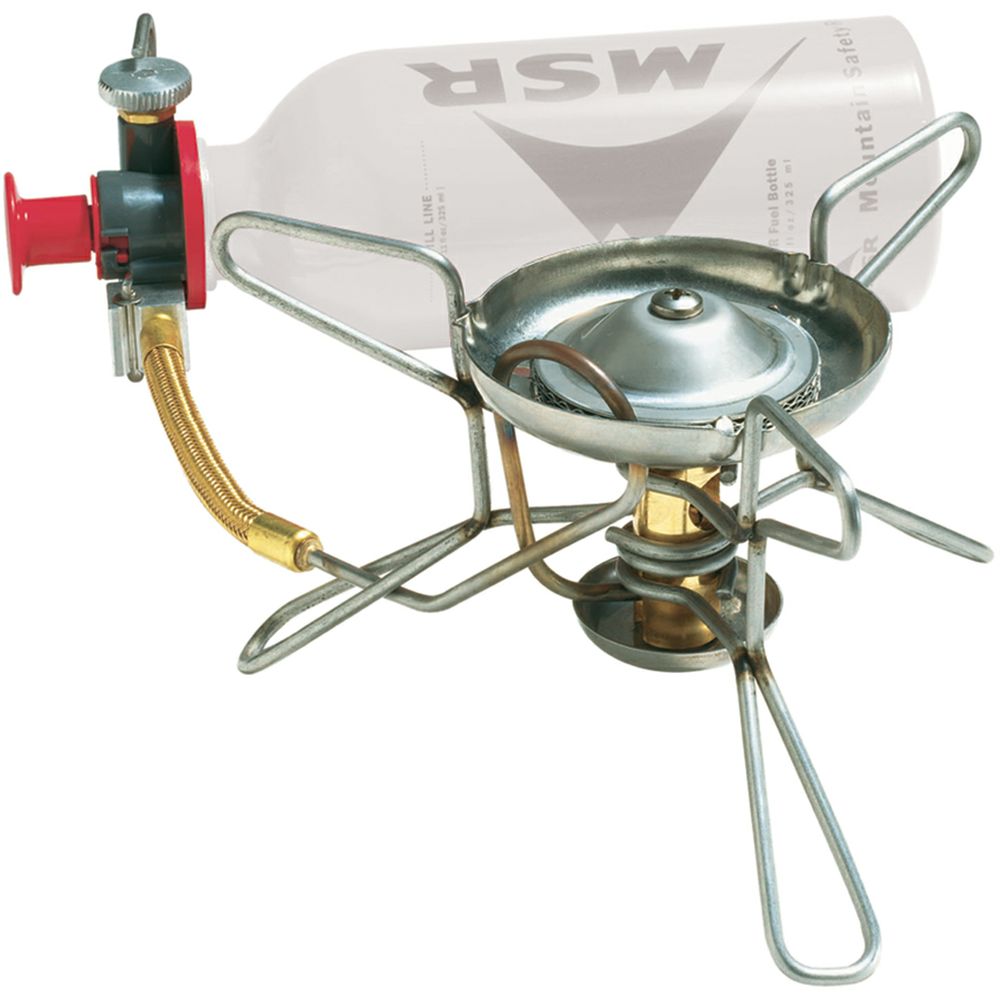
MSR WhisperLite
Best Liquid Fuel Stove for Winter Treks
CleverHiker Rating: 4.1/5.0
Price: $140
Weight: 9.5 oz.
Fuel Type: White gas
Boil Time: 5m 50s
Burn Time (8 oz. fuel): 44m
Pros
- Performs well in extreme cold & high altitude
- Efficient
- Quieter than other liquid fuel stoves
- Stable pot support
Cons
- Slight learning curve
- No simmer control
- Heavy/bulky
- Expensive
The MSR WhisperLite is one of the most popular liquid fuel stoves because it’s among the lightest, smallest, and least expensive on the market. It’s also much quieter than many other roaring liquid fuel stoves. After you get used to the priming process, It’s simple to use and it will last for a long time with regular maintenance. The WhisperLite will work for you in extreme cold and high altitude where canister stoves fail. Even wind has a minimal effect on this stove due its naturally sheltering construction and included windscreen.
Pick up the WhisperLite service kit to keep your stove functioning efficiently. If you want the ability to use fuel types other than white gas, check out the WhisperLite International (white gas, kerosene, unleaded gas) or WhisperLite Universal (white gas, kerosene, unleaded gas, or isobutane-propane). Though it takes a little more time to setup, this stove is great for large groups.
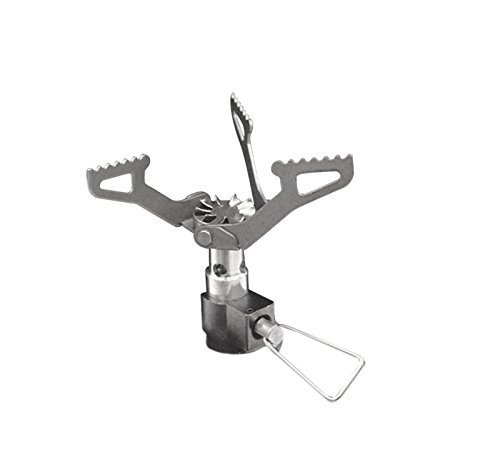
BRS 3000T
Best Budget Ultralight Stove
CleverHiker Rating: 4.1/5.0
Price: $20
Weight: 1 oz.
Fuel Type: Isobutane/propane canister
Boil Time: 4m 45s
Burn Time (8 oz. fuel): 75m
Pros
- Affordable
- Ultralight
- Compact
Cons
- Not as durable as some
- No simmer control
- Knob to turn gas on/off is a little finicky
- Not as good in wind as some
If you’re looking for a super cheap and ultralight stove that’ll work for 1-2 people, the BRS 3000T is about as cheap and light as they come. While the BRS stove isn’t nearly as dependable as many of the other stoves on this list, it has worked well for us over the years.
The BRS doesn’t feel very sturdy so you have to treat it with care. The lightweight material bends easily and the small pot stand requires an attentive eye to avoid spilling the whole pot. Its minuscule price and weight however makes it highly appealing for thru-hikers and ultralight backpackers. Don’t expect any frills with this stove (no simmer control, push-button igniter, fuel regulator, etc.), but it’s great if you just need something cheap and light to get the job done.
We pair the BRS stove with a titanium pot like the Snow Peak Mini Solo Cookset or Toaks Titanium 750mL for a truly ultralight cooking system.
More: BRS 3000T Full Review

Snow Peak GigaPower 2.0
Durable Canister Stove with a Lot of Convenient Features
CleverHiker Rating: 3.8/5.0
Price: $45
Weight: 4.2 oz.
Fuel Type: Isobutane/propane canister
Boil Time: 8m 35s
Burn Time (8 oz. fuel): 30m
Pros
- Lightweight
- Efficient
- Simmer control
- Durable
- Stable pot support
Cons
- Slightly bulkier than some
- Not as good in wind as some
The Snow Peak Gigapower 2.0 is a compact canister stove that’s built to outlast everything else in your pack. Its solid construction features minimal moving parts and seems almost indestructible. Beyond that, it’s convenient and easy to use. It has a push-button igniter, simmer control, and decent boil times.
The Gigapower also has four flat pot supports, which makes it more stable than most three-prong stoves. Snow Peak makes a Gigapower Manual version as well, which is slightly lighter and less expensive, but doesn’t have a push-button igniter.
The Gigapower is not the most efficient stove in the lineup. Its burner is exposed, making it susceptible to wind, and it burns a little more fuel than other stoves. However, it’s lightweight and built to last which we think makes up for its downfalls.

Product Comparison Table
| oSort | Product | Price | Weight | Fuel Type | Boil Time | Burn Time (8 oz. fuel) | Convenience | Weight & Packability | Power & Efficiency | Precision | 0 |
MSR PocketRocket 2 View at REI View at Amazon |
$50 | 2.6 oz. | Isobutane/propane canister | 3m 30s | 60m | 4.3 | 4.8 | 4.5 | 4.2 | 1 |
SOTO WindMaster View at REI View at Amazon |
$70 | 3.1 oz. | Isobutane/propane canister | 3m 5s | 70m | 4.5 | 4.4 | 4.7 | 4.3 | 2 |
MSR WindBurner View at REI View at Amazon |
$200 | 15.3 oz. (Stove & Pot) | Isobutane/propane canister | 2m 55s | 95m | 4.6 | 3.3 | 4.8 | 4.7 | 3 |
Jetboil Flash View at REI View at Amazon |
$130 | 13.1 oz. | Isobutane/propane canister | 2m 40s | 50m | 4.9 | 3.7 | 4.8 | 4.2 | 4 |
Soto Amicus Cookset Combo View at REI |
$50 | 11.2 oz. / 2.7 oz. (Stove & Pot/Stove Only) | Isobutane/propane canister | 4m 20s | 90m | 4.3 | 4.5 | 4.1 | 4.0 | 5 |
Jetboil MiniMo View at REI View at Amazon |
$170 | 14 oz. (Stove & Pot) | Isobutane/propane canister | 3m 30s | 30m | 4.8 | 3.6 | 3.9 | 4.4 | 6 |
Primus Essential Trail View at Amazon View at REI |
$30 | 4 oz. | Isobutane/propane canister | 3m 30s | 60m | 4.1 | 3.9 | 4.5 | 4.3 | 7 |
Snow Peak LiteMax View at REI View at Amazon |
$50 | 1.9 oz. | Isobutane/propane canister | 6m 5s | 60m | 4.1 | 4.9 | 3.5 | 4.2 | 8 |
Solo Stove Lite View at Amazon View at Dick's |
$70 | 9 oz. | Wood | 10m | – | 3.3 | 3.8 | 3.4 | 3.3 | 9 |
MSR WhisperLite View at Backcountry View at Amazon |
$140 | 9.5 oz. | White gas | 5m 50s | 44m | 3.6 | 3.5 | 3.8 | 4.4 | 10 |
BRS 3000T View at Amazon View at Garage Grown Gear |
$20 | 1 oz. | Isobutane/propane canister | 4m 45s | 75m | 3.9 | 5.0 | 3.9 | 3.3 | 11 |
Snow Peak GigaPower 2.0 View at Snow Peak View at Amazon |
$45 | 4.2 oz. | Isobutane/propane canister | 8m 35s | 30m | 3.9 | 4.0 | 3.2 | 3.9 |
|---|
How We Test & Methodology
There are four key metrics we use to test backpacking stoves: convenience, weight and packability, power and efficiency, and precision. We put each stove through on-trail testing as well as rigorous controlled experiments.
CONVENIENCE
Convenience refers to the stove’s overall ease of use and setup. This includes things like ignitor switches, additional pot stands, neoprene sleeves, and pour spout lids. We also factor in overall stove stability by giving it the ‘tip test’. In other words, how easy is it to knock over? All of these elements are taken into account to give it an overall convenience score.
WEIGHT & PACKABILITY
Whether you are an ultralight backpacker or a bushcrafter, the amount of weight you are carrying makes a huge difference. We weigh each stove with and without its extra accessories, measure its size, and see if it’s packable inside a one liter pot along with a fuel canister. This helps us (and you) determine if the overall features of the stove justify its weight and size.
POWER & EFFICIENCY
We assess power and efficiency by how quickly a stove can boil water and how much fuel is consumed in the process. We also look at how that performance changes in a windy environment. A quick boil is a much appreciated feature at the end of a long day and higher efficiency means less fuel is wasted. We time how long each stove takes to boil one liter of water, on high, with and without wind present. Then we measure how much fuel was lost.
PRECISION
Precision is defined by how much simmer control the stove has. Some stoves feature a fuel regulator which significantly increases its range, but even stoves without a regulator usually have some level of variability. With water in a pot, we put it on the stove and try to squeeze out as many definitive changes in flame output as we possibly can. Simmer control is most important to backpackers who want to do more than just boil water. Simmering provides more cooking versatility, allowing you to reheat a meal or even saute.
Why Trust CleverHiker
In addition to controlled lab-style testing, we put all of our backpacking stoves through real life, practical testing in the mountains. Gear Analyst, Brett Kretzer, has backpacked thousands of miles across the US and Europe. He’s thru-hiked the Long Trail, Colorado Trail, the GR11 in the Pyrenees as well as countless other desert and mountain treks. In the process, Brett has put a wide range of gear, including stoves from this list, through the harshest conditions. Through his roles as a gear tester and advisor, he’s learned to analyze and interpret the details that matter in gear selection and has become deeply familiar with how gear can alter the overall experience of a backpacking trip.
Analysis & Results
Whether you’re going for the best performing, most highly featured stove on the market or the one with the most affordable price tag, it’s important to know you are getting the most bang for your buck. We interpret value by weighing the stoves’ overall effectiveness with cost.
VALUE
The PocketRocket 2 stands out as having some of the highest value overall with good stability, efficiency, and simmer control, all in a small package. Although it doesn’t stand out in any one metric, it’s incredibly well-rounded and one of the most affordable stoves on our list. With a slightly larger investment, the SOTO Windmaster offers better overall performance with a faster boil time and the best wind resistance of any ultralight stove.
For convenient, integrated stove systems, the JetBoil Flash takes the cake. This year, JetBoil has stepped up their game with the already easy-to-use Flash. Features like a fast boil time, excellent wind resistance, and an insulated sleeve make this stove system one of the best.
For stoves that are the easiest on the wallet, the Primus Essential Trail and SOTO Amicus Cookset Combo bring the most quality at a great price. Although it’s not the lightest or smallest stove on our list, the Essential Trail boasts impressive power and fuel efficiency at a price that’s hard to beat. The Amicus Cookset Combo includes a small lightweight stove and a two-piece cookset for less than the cost of most stoves.
CONVENIENCE
A stove with handy features that increase its overall functionality is usually easier and more enjoyable to use. Integrated stove systems usually dominate this category, so it’s no surprise that the JetBoil Flash comes out on top. It’s thoughtfully designed with a fuel canister stabilizer, turn-and-click igniter switch, measuring cup, neoprene cozy, heat indicator, and pour spout lid. It has all of the bells and whistles you could ever want in a backpacking stove.
Just behind the Flash are, of course, two more integrated stove setups, the JetBoil MiniMo, and the MSR WindBurner. The MiniMo is wider, more stable, and better for cooking thanks to its built-in fuel regulator. The WindBurner, while lacking a few of the fun things that the Flash includes, is more focused on performance. Nothing beats its superior wind resistance, and it even has great simmer control.
Apart from fully-featured integrated stove systems, some ultralight stoves stand out for their addition of an igniter switch or especially stable pot stand. The SOTO Windmaster and the MSR PocketRocket Deluxe both include an igniter switch in case you lose your lighter, while the Windmaster takes convenience a step further with two interchangeable pot stands.
All of the stoves on our list are highly functional and easy to use, but some have a stronger focus on specialized application, like the MSR Whisperlite for winter expeditions and the Solo Stove Lite for wood-powered bushcraft enthusiasts. Amongst the more minimally designed lightweight stoves, we think the MSR PocketRocket 2 and SOTO Amicus are the easiest to use.

WEIGHT & PACKABILITY
Weight can be a major factor in determining if the convenient features of a stove are actually worth it. Everyone loves a quick boil, but is it worth carrying the extra weight of an integrated system? With a few exceptions, the ratio of weight to added functionality is pretty linear. The more weight, the more convenient and highly featured the stove is.
The BRS 3000T is the clear winner here at just one measly ounce, but at the cost of efficiency, wind resistance, and a stable pot support. For ultralighters just boiling water in a tiny pot, however, the BRS is sufficient.
Just behind at 1.9 ounces is the Snow Peak LiteMax, offering a little more simmer control and stability and a lot more durability. Add another 0.7 ounces and you have the best overall stove on our list, the MSR PocketRocket 2. We think the PR2 balances function and weight the best with its efficient and powerful burner, excellent simmer control, and stability. The SOTO Amicus is an affordable, lightweight stove that features impressive all-around performance, but definitely focuses more on weight savings.
Two more stoves that fall right in the sweet spot are the SOTO WindMaster and MSR PocketRocket Deluxe, featuring a very high level of overall performance in a three-ounce package.
The rest of the standalone stoves, including the Snow Peak Gigapower 2.0 and Primus Essential Trail are slightly heavier with a focus on durability.

POWER & EFFICIENCY
Power and efficiency indicate how well the stove performs its main function – making things hot – and whether or not it uses a ton of fuel in the process. Fuel savings can mean weight and money savings and a quick boil is just nice at the end of a long day or when you’re desperate for your morning coffee.
Hands down, the best stove at being a stove is the MSR WindBurner. It boils water quickly while using hardly any fuel. The enclosed burner with the integrated pot allows it to maintain most of that performance even in high winds.
Not far behind is another integrated stove system, the JetBoil Flash which ranks as the best value integrated system on our list. While it’s not quite as efficient as the WindBurner, it adds some extra practical features that are a nice touch.
The SOTO WindMaster impressed us with its ability to compete with integrated stove systems in efficiency and wind performance. The WindMaster features a highly effective collared burner and a strong fuel output, making it the most powerful lightweight stove on our list.
The Primus Essential Trail and MSR PocketRocket 2 also performed surprisingly well at boiling water in windy conditions. The Essential Trail in particular features solid pot supports which double as efficient wind blockers.
The SOTO Amicus, considering its incredibly affordable price point, stood up as a very capable stove compared to more expensive options. SOTO’s quality construction was not lost on this budget option.
If power and efficiency are your main concerns when purchasing a lightweight backpacking stove, we would recommend steering clear of the Snow Peak LiteMax and Snow Peak Gigapower 2.0. Although they are lightweight and extremely durable, their side-address burner vents are highly exposed, making them particularly vulnerable to the wind. We would recommend pairing these models with a lightweight windscreen.

PRECISION
For folks who enjoy adding a layer of complexity to their backcountry meals, the versatility of a simmer control is an important feature. The secrets behind a high level of cooking precision are a built-in fuel regulator, which allows minute changes in fuel output, and excellent wind resistance that allows a small flame to burn without blowing out.
The MSR WindBurner impressed us yet again by having the highest level of flame variability. It has the best wind resistance of any of the stoves on our list, a fuel regulator, and a wide burner. The JetBoil MiniMo sets itself apart from its sibling, the Flash, due to its built-in fuel regulator, but we found it to be the least wind-resistant of the integrated stoves.
The best folding stoves in this category are the MSR PocketRocket Deluxe and the SOTO WindMaster. Both have a fuel regulator, and the WindMaster is especially wind resistant for a small, lightweight stove.
Despite their lack of a fuel regulator, Primus Essential Trail and MSR PocketRocket 2 have remarkably good simmer control. We love the wide burner surface of the Essential Trail as it creates a more dispersed flame, thus more even heating.
We would recommend reserving the remaining stoves for either boiling water or very attentive cooking, especially the MSR Whisperlite, which essentially has nothing more than an on and off mode.
How to Choose a Backpacking Stove
FUEL TYPES
Isobutane/propane canister stoves are the most common and convenient, and they’re the easiest to use. Liquid fuel stoves are the most efficient for trips at high altitude or below-freezing temperatures. Wood stoves are nice because you don’t have to lug fuel around, but they don’t work for trips above treeline or in most desert environments. Solid fuel stoves and alcohol stoves are generally pretty budget-friendly and ultralight, but you can’t control the flame, they yield slow boil times, and they’re not great in wind.
Forest fire danger is an important consideration for any stove user any time of year, but especially when conditions are hot and dry. Fire ban rules differ from place to place, so check the specific regulations in your area. In some strict fire ban areas, all stove usage is prohibited, but that’s not common. In general, canister stoves are usually viewed as the safest option. Solid fuel stoves may be permitted as well. Wood stoves and alcohol stoves are usually not permitted. Liquid fuel stoves may be allowed, but exercise extreme caution when priming. Spilling highly flammable fuel while priming is easy to do and could quickly start a fire.
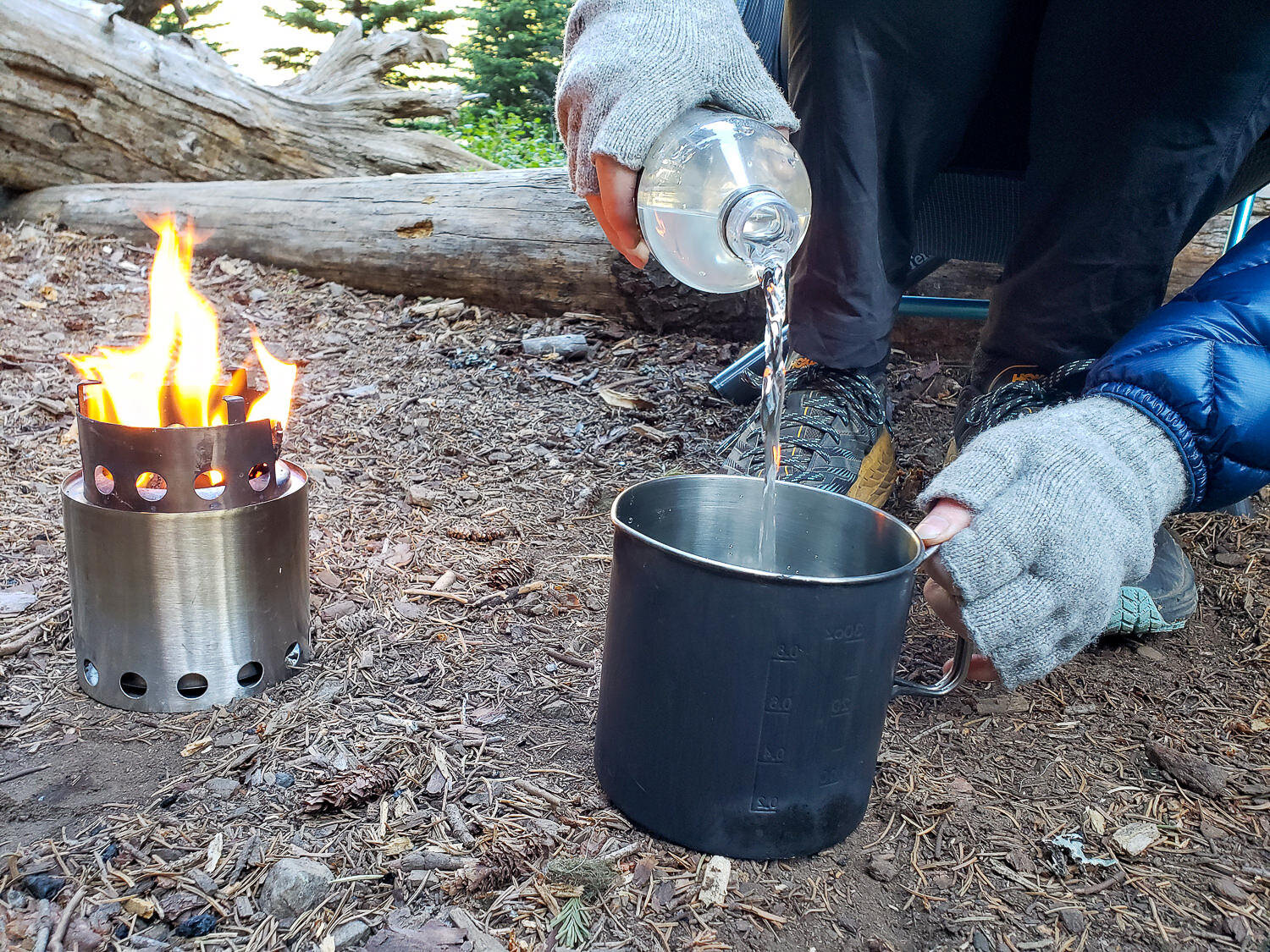
COST
Typically the more you spend, the more features you get with backpacking stoves. More expensive stoves are likely to have better simmer control, superior wind performance, and many even come with an integrated cook pot. Hikers just looking to boil water for rehydrating meals may find that saving money with a less feature-rich option better suits their needs.

WEIGHT
While it might not seem like a couple of ounces should make a big difference in the grand scheme of things, ounces add up into pounds, and when you’re carrying that weight for tens of miles per day, your body can feel the difference. When choosing a stove, we try to find the best balance between functionality and weight.

PACKABILITY
When we’re packing our bag, we like each piece of gear to fit neatly into its place and not take up an excessive amount of space. Many stoves fold down small enough to nestle into a pot along with a small fuel canister and a lighter, making the entire cookset conveniently contained in a single vessel. Most integrated systems are specifically designed to pack away like this. If we have to pack our fuel canister or stove separately, away from the rest of our cookset, we factor that into our stove selection.

BOIL TIME
Most backpackers these days make very simple meals that only require boiling water to rehydrate food. For that reason, the main purpose for most backpacking stoves is to boil water quickly, not necessarily to cook. The quicker this can happen, the better.

EFFICIENCY
Just like your car, some stoves are more fuel-efficient than others. The rate at which a stove burns through fuel determines how long a single canister will last and how much fuel you need to carry. It’s not the most important spec in our book, but it’s worth taking into consideration.

WIND PERFORMANCE
Backpacking stoves don’t like wind. Strong winds will whip away heat before it ever gets to your pot, which will make your stove far less efficient. Some stoves perform better in windy conditions (integrated canister stoves) and others perform very poorly (alcohol stoves, wood stoves, and solid fuel stoves). For that reason, a windscreen is recommended with most backpacking stoves.

STABILITY
Knocking a fully cooked dinner onto the ground is the pits. Unless you enjoy eating dirt, you’re going to want to avoid that move at all costs. If you plan to cook large meals in big pots, get a stove with a wide base that will rest securely on the ground. Smaller pots used with upright canister stoves will work just fine, but they do tend to be a little less stable, so cook with care.

SIMMER CONTROL
If you want the ability to cook more complex trail meals, you’ll definitely want a stove with good simmer control. Some canister stoves and liquified gas stoves have this feature, but not all of them. Simmer control can be a handy feature even if you only plan on making simple backcountry meals. It’s a lot easier to keep a pot from boiling over when you have a choice between off and turbo.

IGNITER SWITCH
Igniter switches are a convenience feature usually reserved for higher-end stoves. It’s nice to light your stove at the push of a button and have a backup for if your lighter gets wet. That being said, we do recommend always carrying a lighter regardless of your stove model because igniter switches are usually the first feature to break on a stove.

INTEGRATED SYSTEMS
Integrated systems are usually more efficient, stable, and more convenient than traditional backpacking stoves. They come with an included pot that screws directly into the stove, which helps to block wind and makes for a quicker boil time. On the flip side, an integrated system is almost always going to be pricier and heavier than typical canister stoves. Some people don’t mind carrying the extra weight for the added convenience of an integrated system, but most ultralight backpackers will steer clear.

CONCLUSION
There are a number of factors to consider when choosing the right backpacking stove. Whether you’re focused on minimizing weight or enhancing your outdoor cooking experience, factors like convenience, weight and packability, power and efficiency, and precision are crucial. Everyone prioritizes different features in a stove, and we hope this guide has helped you determine which stove is best for your purposes.







